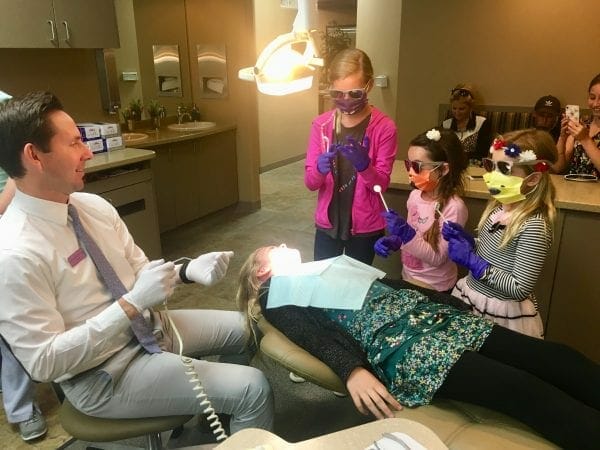What Are the Three Stages of Orthodontic Treatment?
Regardless of the orthodontic issues that need to be addressed, all our patients go through three stages of orthodontic treatment. These three stages are:
- Planning Stage — involves photos, necessary x-rays, 3D imaging, and any preparatory work needed before the application of braces or Invisalign
- Active Stage — the patient actively wears braces or Invisalign
- Retention Stage — focuses on holding teeth in their new position with retainers
In this article, we’ll look at what is involved with each stage of orthodontic treatment, so our patients are prepared and know what to expect at each step of their orthodontic experience.
1: Planning Stage
The planning stage is critical to achieving a good result. It is when our doctors plan out the treatment needed to address the orthodontic issues that the patient presents with. Because each patient is unique, each treatment plan is unique as well.
The process begins with a thorough exam of the patient’s mouth and supporting structures. Orthodontic records will be taken of the patient including photos, digital x-rays, and in some cases 3D imaging. During the initial consultation, our doctors will also gather information on a prospective patient’s medical and dental history. Certain medical issues can be connected to oral health problems and our doctors want to ensure that any prior medical or dental health issues are under control before treatment begins.

At the end of the exam appointment, Dr. Redford or Dr. Burke will provide a personalized treatment plan. Part of the personalized treatment plan will include recommendations for the type of braces that can be used. Typical braces types include:
Although patients may have their heart set on a certain type of treatment option (such as Invisalign), it is important to know that not every treatment option is suitable for each case. For example, while Invisalign does an excellent job of correcting a wide variety of orthodontic issues, it is not as effective as braces in correcting more serious bite issues and issues such as severely rotated teeth, large vertical movement of teeth, and serious dental midline shifts.
When our doctors present the treatment plan, they will answer questions about braces, provide information on what to expect, give an expected timeline for treatment, and provide cost information (including what will be covered by insurance). Information on how to properly care for braces or Invisalign trays will be provided, including what foods to avoid while wearing braces.

Common Treatments Before Braces or Invisalign
For some patients (particularly younger children), our doctors may recommend the use of various orthodontic appliances (such as a palatal expander). These devices help to widen the jaw and make enough room for teeth to fit properly in the mouth. For other patients, treatment may require a tooth extraction or the use of specialized orthodontic appliances.
Once the treatment plan is finalized, preparatory work for Invisalign patients—such as creating a digital 3D model of the patient’s mouth using our iTero scanner—will be completed. This advanced digital scanning system replaces the older impression systems that required gooey molds. The scans are painless, gag-free, fast, and provide a more accurate fit for the aligner trays.
2: Active Stage
As the name indicates, the active stage is when the braces or Invisalign are placed/delivered and begin to do their work of putting teeth into their correct positions and correcting bite issues. Braces and Invisalign accomplish this by applying steady gentle pressure to the teeth, which stimulates bone remodeling and moves teeth into alignment. Although this may sound scary, the soreness experienced usually lasts only a few days. After getting accustomed to the adjustments made, most patients hardly notice their braces or aligners.
During the active stage of braces treatment, there are three “sub-stages” that focus on specific treatment goals.
- Alignment and Leveling. The first part of the active stage focuses on aligning and leveling teeth. Alignment means moving and straightening teeth to form a healthy curved arch. Leveling means ensuring that teeth are all the same height.
- Bite Correction. This stage focuses on correcting any bite issues by closing spaces, ensuring the upper and lower teeth come together properly, and making sure that teeth meet in the proper relationship. Elastics will be used to correct the bite and good cooperation is important to achieve a good result.
- Once alignment, leveling, and bite correction are completed, the final stage is finishing, which means making final adjustments to ensure the result is an attractive smile and a healthy bite.

3: Retention Stage
Once the braces are removed or the last Invisalign tray is used, treatment focuses on keeping teeth in their new places. Without the retention (or maintenance) stage, teeth can shift back into an unfavorable or unwanted place over time.
The key to smile maintenance after Invisalign or braces is wearing a retainer. It takes a while for the teeth to become stable in their new position. This is because the bones, gums, and muscles need to adapt to the new position of the teeth. In addition, chewing, growth, and everyday wear all cause teeth to slowly move over time. A retainer is used to keep the teeth from moving. Without this stage, all the work done in the previous stages can be nullified.

All About Retainers
Patients will be provided retainers based on their unique orthodontic needs and personal preferences. The three types of retainers provided at our office include:
- Clear retainers (also known as Essix or vacuform retainers), which look like Invisalign trays and can be removed for eating, drinking, brushing, and flossing. These hold alignment very well as they adapt intimately to all surfaces of the teeth.
- Hawley retainers are made from metal and acrylic and are also removable. These retainers are very durable.
- Bonded retainers are also known as “permanent retainers” or “fixed retainers”. These are typically used only for the lower teeth and are the most retentive type of retainer.
For the best results, retainers should be worn indefinitely. During the first two months after the end of the active stage, retainers should be worn all day and night, except for when eating, drinking, or cleaning teeth. Once cleared by Dr. Redford or Dr. Burke, retainers will only need to be worn at night.
Burke & Redford Orthodontists have been treating children and teenagers for more than 30 years in Temecula and Lake Elsinore. Give us a call at (951) 699-8011 or contact us through our website with questions or to schedule a free orthodontic consultation.